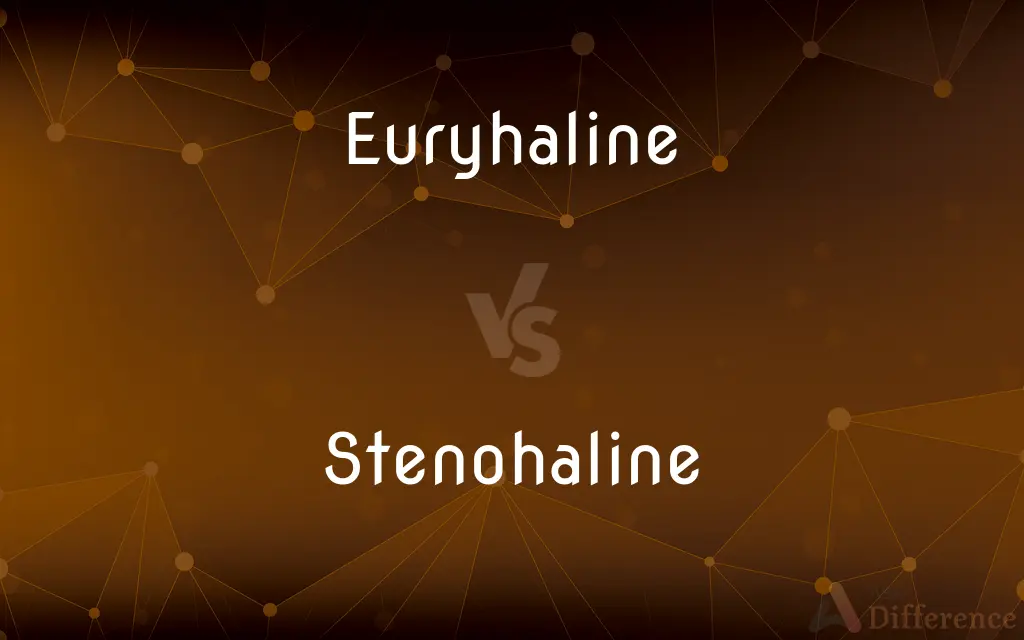Euryhaline vs. Stenohaline — What's the Difference?
By Fiza Rafique & Urooj Arif — Updated on March 15, 2024
Euryhaline organisms can tolerate a wide range of salinities, ideal for fluctuating environments, whereas stenohaline species thrive in stable salinity conditions, being less adaptable to change.

Difference Between Euryhaline and Stenohaline
Table of Contents
ADVERTISEMENT
Key Differences
Euryhaline species are adapted to environments where salinity levels can vary significantly, such as estuaries, allowing them to survive in both fresh and saltwater. Stenohaline organisms, on the other hand, are found in environments with relatively stable salinity levels, such as open oceans or freshwater lakes, and can become stressed or perish if salinity changes.
The adaptability of euryhaline organisms involves complex physiological mechanisms that regulate internal salt concentrations, effectively dealing with the osmotic stress from varying external salinities. Conversely, stenohaline species have a more limited range of physiological adjustments, making them more susceptible to changes in their aquatic environment's salinity.
Euryhaline species, such as the salmon, which migrates between fresh and saltwater, showcase the evolutionary advantages of being able to exploit diverse habitats and resources. In contrast, stenohaline species, like many tropical fish kept in aquariums, demonstrate the evolutionary trade-offs of specializing in stable environments, which can limit their geographic distribution.
The presence of euryhaline species in fluctuating salinity conditions highlights their role in maintaining ecosystem resilience and biodiversity. Stenohaline organisms, while less adaptable, contribute to the biodiversity of stable saline or freshwater ecosystems by occupying specific ecological niches.
Despite their differences, both euryhaline and stenohaline species are integral to aquatic ecosystems, contributing to the ecological balance and diversity of marine and freshwater environments.
ADVERTISEMENT
Comparison Chart
Salinity Tolerance
Wide range of salinities
Narrow range of salinities
Preferred Environments
Estuaries, brackish waters
Stable environments (open oceans, freshwater lakes)
Physiological Mechanisms
Complex osmoregulation
Limited osmoregulation
Adaptability
High
Low
Role in Ecosystems
Enhances resilience and biodiversity
Contributes to specific ecological niches
Compare with Definitions
Euryhaline
Capable of adapting to a wide range of salinities.
The eel is euryhaline, living in both freshwater and marine environments.
Stenohaline
Having a narrow range of salinity tolerance.
Many coral species are stenohaline, thriving only in specific marine conditions.
Euryhaline
Having broad salinity tolerance benefits survival.
Euryhaline organisms exploit diverse habitats, enhancing their distribution.
Stenohaline
Organisms that require stable salinity conditions.
Stenohaline fish are often sensitive to changes in their aquatic environments.
Euryhaline
Reflecting adaptability to both saltwater and freshwater.
Euryhaline crustaceans migrate between different salinities.
Stenohaline
Suited to either freshwater or marine settings, but not both.
Stenohaline freshwater species can perish in slightly brackish water.
Euryhaline
Species found in environments with fluctuating salinity.
Mangrove species are euryhaline, adapting to estuarine conditions.
Stenohaline
Emphasizing the ecological niche occupation.
Stenohaline species contribute to the biodiversity of their specific habitats.
Euryhaline
Euryhaline organisms are able to adapt to a wide range of salinities. An example of a euryhaline fish is the molly (Poecilia sphenops) which can live in fresh water, brackish water, or salt water.
Stenohaline
Indicating specialization in stable environments.
Stenohaline organisms are less adaptable to salinity fluctuations.
Euryhaline
Capable of tolerating a wide range of salt water concentrations. Used of an aquatic organism.
Stenohaline
Stenohaline describes an organism, usually fish, that cannot tolerate a wide fluctuation in the salinity of water. Stenohaline is derived from the words: "steno" meaning narrow, and "haline" meaning salt.
Euryhaline
Able to tolerate various saltwater concentrations.
Stenohaline
Limited to or able to live only within a narrow range of saltwater concentrations. Used of aquatic organisms.
Stenohaline
(biology) Tolerant of only a narrow range of saltwater concentrations. Used of aquatic organisms
Common Curiosities
Can stenohaline species adapt to salinity changes?
Stenohaline species are less adaptable to salinity changes, which can lead to stress or death if their environment's salinity levels fluctuate significantly.
What defines a euryhaline organism?
Euryhaline organisms can tolerate a wide range of salinities, making them adaptable to different aquatic environments.
How do euryhaline organisms regulate their internal environment?
Through complex physiological processes, euryhaline organisms regulate their internal salt concentrations to match external conditions.
Why are euryhaline species important?
They play a crucial role in ecosystem resilience and biodiversity, especially in fluctuating environments like estuaries.
Can euryhaline species live in freshwater and saltwater?
Yes, many euryhaline species can live in both freshwater and saltwater at different stages of their life cycle.
What is a stenohaline organism?
Stenohaline organisms thrive in stable salinity conditions and have a narrow tolerance range for salinity changes.
How does climate change affect euryhaline and stenohaline species?
Climate change can alter salinity levels in aquatic environments, potentially benefiting adaptable euryhaline species and threatening stenohaline species.
What environments do stenohaline species prefer?
They prefer environments with stable salinity levels, such as deep-sea conditions or freshwater ecosystems.
Why are estuaries important for euryhaline species?
Estuaries offer a transition zone between freshwater and marine environments, providing a habitat for euryhaline species to thrive.
What is osmoregulation?
Osmoregulation is the process by which organisms regulate their internal water and salt concentrations to maintain homeostasis.
Are all marine organisms euryhaline?
No, not all marine organisms are euryhaline; many marine species are stenohaline, requiring stable salinity levels.
What adaptations help euryhaline organisms survive in variable salinities?
Euryhaline organisms have developed adaptations like efficient osmoregulation and salt excretion mechanisms to survive in variable salinities.
How do stenohaline and euryhaline species differ in evolutionary terms?
Euryhaline species have evolved to exploit diverse environments, whereas stenohaline species have specialized in stable salinity conditions.
What challenges do stenohaline species face in changing environments?
Stenohaline species may face survival challenges in changing environments due to their limited salinity tolerance.
What factors influence an organism's salinity tolerance?
Genetic adaptations, physiological mechanisms, and environmental conditions influence an organism's salinity tolerance.
Share Your Discovery

Previous Comparison
Beautiful vs. Fine
Next Comparison
Downtown vs. SuburbAuthor Spotlight
Written by
Fiza RafiqueFiza Rafique is a skilled content writer at AskDifference.com, where she meticulously refines and enhances written pieces. Drawing from her vast editorial expertise, Fiza ensures clarity, accuracy, and precision in every article. Passionate about language, she continually seeks to elevate the quality of content for readers worldwide.
Co-written by
Urooj ArifUrooj is a skilled content writer at Ask Difference, known for her exceptional ability to simplify complex topics into engaging and informative content. With a passion for research and a flair for clear, concise writing, she consistently delivers articles that resonate with our diverse audience.















































